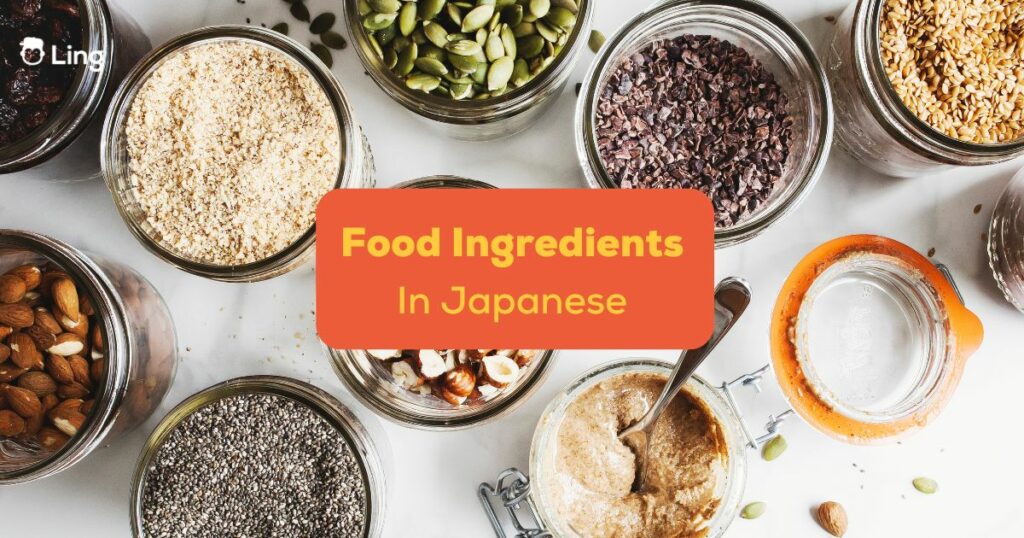Japanese food ingredients are known for being incredibly diverse and unique. And they make up some of the best dishes that Japanese cuisine has to offer! The food scene in this wonderful country is vibrant and interesting: from fresh takoyaki (deep-fried octopus balls) to a fruity concoction of native nashi pears and persimmons in a smoothie, there are so many flavors to munch on!
If you’re moving to Japan soon, or perhaps just visiting, this guide will help you when the time comes to do some food shopping. So get ready to learn some key words and phrases in the Japanese language before you head out to the local grocery store!

Names For Japanese Vegetables
Vegetables are a staple in Japanese food culture. From the pungent sourness of pickled carrots to the hearty stems of bok choy, there’s always room for vegetables on a traditional Japanese plate. If you’ll be staying at a Japanese homestay, your family will appreciate you bringing back a variety of fresh vegetables to cook with, as they are nutritious and can be spiced up into a healthy and delicious treat for everyone.
Below is a list of words you might need to know when shopping for vegetables in Japan.
Cabbage – キャベツ (Kyabetsu)
Cabbage, or キャベツ (kyabetsu), is the star ingredient in a lot of Japanese dishes. It is a bulky, inexpensive ingredient that packs a lot of volume into food and can be dressed up in any way or flavor you like! It’s usually sliced into thin strips and served in a dish like katsu (deep-fried pork or chicken cutlet). Not only that, but it’s a super versatile ingredient that can be added to soups, fried foods, or salads.
Fun fact: Japan is one of the world’s biggest producers of cabbage, and the vegetable sells like hotcakes at the local supermarkets. So, if your homestay family has it on the shopping list, make sure to get there early before it sells out!
Carrot – にんじん (Ninjin)
In Japan, carrots, or にんじん (ninjin), are often thicker than the ones found in Western markets. The taste is similar, but they are prepared in different ways than their American or European counterparts. They are also frequently sliced into fun and cute shapes like stars or hearts to add a fun sprinkle of visual appeal to a dish. Carrots can also be used in a variety of ways, from eaten raw to cooked in a curry or stew, or just as a garnish to add a pop of color to a dish.
Daikon Radish – だいこん (Dai-kohn)
Daikon – だいこん (dai-kohn) – is a type of root vegetable from the radish family. Along with cabbage, it’s a very popular and versatile vegetable that can be eaten raw or cooked. Part of the reason why daikon is so important in Japanese cooking is that it carries a handy substance that counteracts the oiliness of grilled dishes like tempura or fried fish. Just like other radishes, the bottom half of the daikon gives a spicy sensation, but when it’s cooked the flavor turns slightly sweet.
Ginger – しょうが (Shoga)
Ginger, or しょうが (shoga), is something you’ll definitely smell and taste a lot of in Japanese food culture. A staple ingredient that adds a lot of punch, ginger is used in almost all dishes you’ll find in the country. It’s commonly regarded as a “winter” flavor because it adds heat to dishes like soups and curries.
Other ways in which ginger is used include as a flavor enhancer to sushi, in a dipping sauce, or on top of tofu. Furthermore, it’s often thinly sliced into a pink ribbon to pile over a piece of sushi, tofu, or heavy meats that can handle the hefty and aromatic spice that ginger brings.
Onion – たまねぎ (Tamanegi)
Onion – たまねぎ (tamanegi) – is also important in many Japanese dishes, and it shows because the country is one of the world’s top producers of the vegetable, churning out millions of onions to market for people to buy every day. It’s commonly used, just like in other countries, as a base ingredient for flavor. Essential in dishes like curries and rice-based foods, onion is definitely going to be on your shopping list!
Japanese Fruits
Fruits, or くだもの (kudamono), are very important for the Japanese diet. Rich in healthy, natural sugars, Japanese people love to use natural fruits in their cooking. Native fruits like persimmon, pears, and peaches are great, safe options to pluck from grocery store shelves as a quick snack your Japanese homestay family will surely love.
Sometimes, fruits are more than just something yummy to eat. Farmers get creative while cultivating different kinds of fruits, elevating them into stylish, tasty sculptures of an array of shapes, sizes, and flavors.
They are certainly good enough to eat, though you might not want to since they look so pretty! From a square watermelon to a perfectly rounded peach to a bunch of grapes that are rumored to taste exactly like candy, there’s a plethora of fruits that you might be craving to sink your teeth into.
Whether you’re looking for one of the crazy, new fruit trends you’ve seen online, or you’re more into the typical fruits, here’s a list of common fruits you’ll find in Japanese stores.
| English | Japanese | Romanization |
|---|---|---|
| Dragonfruit | ドラゴンフルーツ | doragonfurūtsu |
| Orange | みかん | mikan |
| Watermelon | スイカ | suika |
| Peach | 桃 | momo |
| Lemon | レモン | remon |
| Plum | 梅 | ume |
| Strawberries | 苺 | ichigo |
| Persimmon | 柿 | kaki |
| Lychee | ライチ | raichi |
| Pear | 梨 | nashi |

Other Common Japanese Food Ingredients
Beyond fruits and vegetables, spices, grains, and marinades are also essential to cooking dishes in a Japanese household. They all bring a ton of flavor and pizzazz to the plate! Below, I’ll list other common ingredients that are essential when creating a delicious miso soup, udon noodles, onigiri, or anything else that might be on the menu! Take a peek inside the staples in a Japanese pantry.
Sauces And Marinades
- Soy sauce – 醤油 (sho-yoo)
- Rice vinegar – 米酢 (me-soo)
- Sake – 酒 (sah-keh)
- Miso – 味噌 (mee-soh)
- Mirin – みりん (mee-reen)
Grains And Bases
- White rice – ご飯 (gohan)
- Sushi rice – 鮨飯 (sushi meshi)
- Noodles – 麺 (men)
- Tofu – 豆腐 (toe-foo)
Toppings And Garnish
- Sesame seeds – ゴマ (goma)
- Pickled vegetables – 漬物 (tsukemono)
- Bonito flakes – おかか (okaka)
Japanese Cooking
Traditional Japanese food culture has some staple recipes that are famous worldwide. Those rice balls, simmered dishes, seafood dishes, and soba noodles are all classics that are expected to be on the menu when visiting or staying in a Japanese household.
It can be a real challenge to cook Japanese food, especially if you have trouble reading the labels on items while out shopping! But by practicing vocabulary for these common recipes, you may be able to get some help with the dish you are hoping to make.
Below is a list of other common Japanese ingredients that you should know in case you find yourself in an Asian specialty grocery store with no clue on how to say a particular word.
| English | Japanese | Romanization |
|---|---|---|
| Japanese savory pancake | お好み焼き | okonomiyaki |
| Soba noodles | そば | soba |
| Udon noodles | うどん | udon |
| Ramen | ラーメン | ramen |
| Fried pork cutlets | とんかつ | tonkatsu |
| Japanese dumplings | 団子 | dango |
| Miso paste | 味噌 | miso |
| Wasabi | わさび | wasabi |
| Nori | 海苔 | nori |
Learn Japanese With Ling!
Now that you’ve learned words for vegetables, fruits, and other common Japanese food ingredients, you must be ready to go shopping! Be sure to practice these words when you’re at the grocery store because your homestay family will definitely need your help cooking delicious and traditional Japanese recipes.
Hungry for more? Check out the Ling app for lessons in Japanese that go beyond food! Dive into learning greetings, numbers, and much more. You’ll also get instant feedback on your pronunciation, practice Japanese characters, and even have conversations with a chatbot. So download the Ling app from the App Store or Play Store and start your Japanese learning journey!

































































